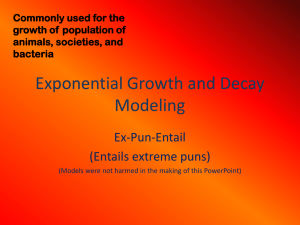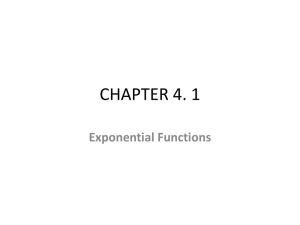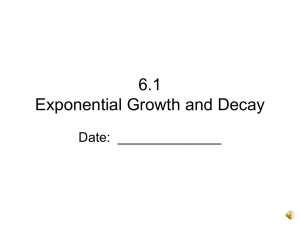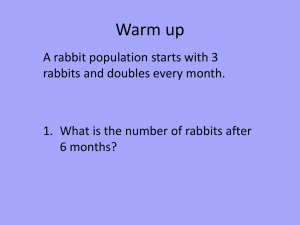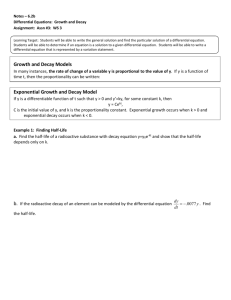here - BCIT Commons
advertisement
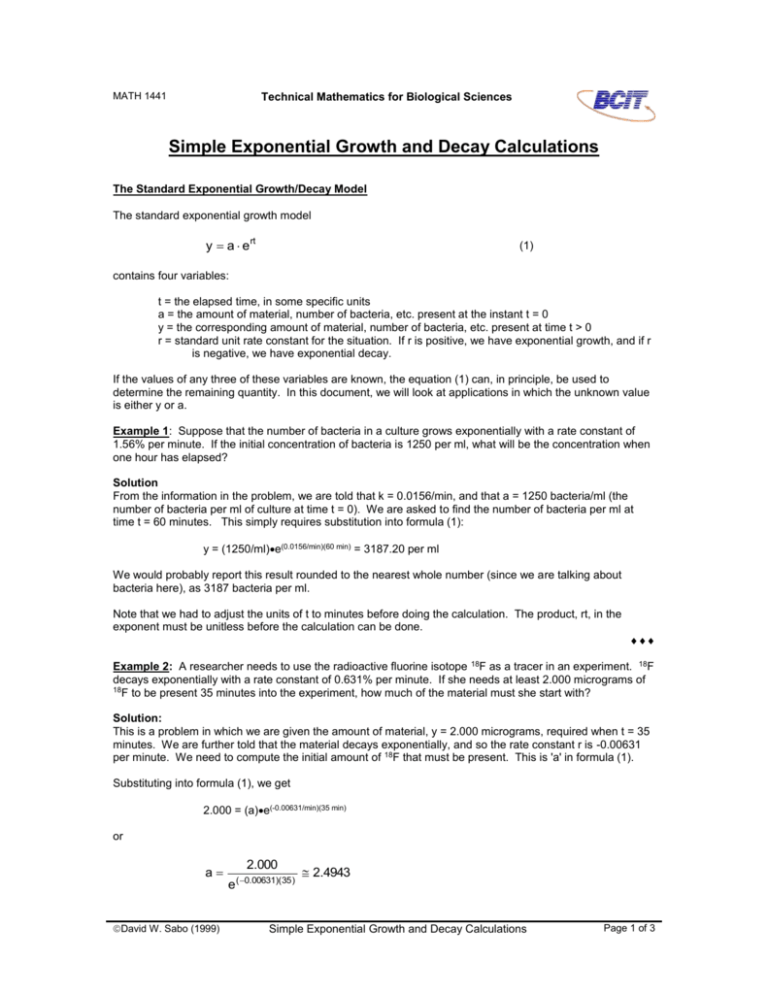
MATH 1441 Technical Mathematics for Biological Sciences Simple Exponential Growth and Decay Calculations The Standard Exponential Growth/Decay Model The standard exponential growth model y a e rt (1) contains four variables: t = the elapsed time, in some specific units a = the amount of material, number of bacteria, etc. present at the instant t = 0 y = the corresponding amount of material, number of bacteria, etc. present at time t > 0 r = standard unit rate constant for the situation. If r is positive, we have exponential growth, and if r is negative, we have exponential decay. If the values of any three of these variables are known, the equation (1) can, in principle, be used to determine the remaining quantity. In this document, we will look at applications in which the unknown value is either y or a. Example 1: Suppose that the number of bacteria in a culture grows exponentially with a rate constant of 1.56% per minute. If the initial concentration of bacteria is 1250 per ml, what will be the concentration when one hour has elapsed? Solution From the information in the problem, we are told that k = 0.0156/min, and that a = 1250 bacteria/ml (the number of bacteria per ml of culture at time t = 0). We are asked to find the number of bacteria per ml at time t = 60 minutes. This simply requires substitution into formula (1): y = (1250/ml)e(0.0156/min)(60 min) = 3187.20 per ml We would probably report this result rounded to the nearest whole number (since we are talking about bacteria here), as 3187 bacteria per ml. Note that we had to adjust the units of t to minutes before doing the calculation. The product, rt, in the exponent must be unitless before the calculation can be done. Example 2: A researcher needs to use the radioactive fluorine isotope 18F as a tracer in an experiment. 18F decays exponentially with a rate constant of 0.631% per minute. If she needs at least 2.000 micrograms of 18F to be present 35 minutes into the experiment, how much of the material must she start with? Solution: This is a problem in which we are given the amount of material, y = 2.000 micrograms, required when t = 35 minutes. We are further told that the material decays exponentially, and so the rate constant r is -0.00631 per minute. We need to compute the initial amount of 18F that must be present. This is 'a' in formula (1). Substituting into formula (1), we get 2.000 = (a)e(-0.00631/min)(35 min) or 2.000 a e David W. Sabo (1999) ( 0.00631)( 35 ) 2.4943 Simple Exponential Growth and Decay Calculations Page 1 of 3 Thus, it appears that the researcher needs to start the experiment with at least 2.494 micrograms of ensure that at least 2.000 micrograms of the material will still be present 35 minutes later. 18F to Example 3: At the end of 1996, Canada's population was estimated to be 29, 672,000, with a growth rate of 1.06% per year. (a) Assuming an exponential growth model with the given growth rate, estimate the Canadian population size at the end of the year 2010. (b) According to Statistics Canada, there were 20,015,000 people in Canada at the end of 1966. Is this consistent with an exponential growth model based on the 1996 data? Solution: (a) The required result is obtained by simple substitution into formula (1). We are given that a = 29,672,000, and k = 0.0106, and we are asked to find the value of y when t = 2010 - 1996 = 14 The result is y = (29,672,000)e(0.0106)(14) = 34,418,831 We should probably round our final result off to the nearest 1000 to match the precision of the initial information, estimating the size of the Canadian population at the end of 2010 to be approximately 34,418,000. (b) One thing we could do to answer this question is to calculate what the population should have been at the end of 1966 in order to give a population of 29,672,000 through exponential growth at 1.06% per year at the end of 1996, and elapsed time of 30 years. In this case, 'a' would represent the initial population size in 1966, and y = 29,672,000 would be the population size at t = 30 years. Substituting into formula (1) gives 29,672,000 = ae(0.0106)(30) so that a 29,672,000 e (0.0106 )(30 ) 21,589,430 This is quite a bit larger than the actual 20,015,000 known size of the population at the end of 1966. This would seem to indicate that either a somewhat higher growth rate than 1.06% per year occurred between 1966 and 1996, or perhaps the population growth was not entirely due to a simple exponential growth process. (You could also calculate the expected population size at the end of 1996 starting with a population of 20,015,000 at the end of 1966 and an annual growth rate of 1.06%. You would find that the expected population size is smaller than the actual population size achieved, leading to the same sort of conclusion as described above.) Newton's Cooling Formula Newton's cooling formula illustrates another application of the simple exponential growth/decay model. It is convenient to write the formula in the form 0 e kt (2) where t = elapsed time from when cooling of the material begins (at t = 0) 0 = the difference in temperature between the hot material and its cooler environment when t = 0, Page 2 of 3 Simple Exponential Growth and Decay Calculations David W. Sabo (1999) = the difference in temperature between the hot material and its cooler environment at some later time t, and k = a negative number representing a cooling rate constant. This formula is a good description of passive cooling of material as long as the temperature of the immediate environment is kept constant. Thus, it would not work well if as the hot material cooled, it caused its immediate surroundings to heat up significantly. Take careful note that the quantities and 0 are temperature differences, not the actual temperatures of the material. Formula (2) is saying that it is the difference in temperature between a hot material and its cooler environment that decays exponentially. When the material and its environment are at the same temperature (so that 0 = 0), no further cooling will take place. Example 4: A large vat of jam cools with a rate of cooling of -0.15% per minute. The initial temperature of the jam is 1020C in a well ventilated room with a temperature of 23 oC. Assuming Newton's cooling formula applies, determine what the temperature of the jam will be after two hours have elapsed. Solution: When t = 0, we have that the jam is at a temperature of 1020C and the environment has a temperature of 230C. Therefore, 0 = 1020C - 230C = 790 The cooling rate constant is given in units of "per minute", so we must convert the t = 2 hours elapsed time to its equivalent 120 minutes before substituting into formula (2). Doing that gives = (79)e(-0.0015/min)(120 min) = 65.986 Thus, after two hours have elapsed, the jam will still be hotter than the environment by nearly 66 0C. This means that its temperature will be 660C + 230C = 890C Where to from here? Having thought a bit about the examples described above, two things may have occurred to you. being able to calculate how much time must elapse for a certain amount of growth or decay to occur would be useful and interesting in some situations. With either formulas (1) or (2), that requires solving an exponential equation an equation in which the unknown is in an exponent. Such an equation cannot usually be solved by ordinary algebraic methods, but rather, require the use of logarithms. Our next task in this course will be to describe those properties of logarithms that can be exploited to solve this kind of exponential equation. in actual practical applications, the values of the rate constants (r in formula (1) and k in formula (2)) must be determined from experimental observations or measurements. If just two observations are available, then determining the value of r or k requires solution of an exponential equation. If more than two observations are available, we can estimate values of the rate constant by analyzing graphs with logarithmic scales. In fact, this approach allows us to compensate to some extent for measurement errors as well. The preparation and interpretation of logarithmic-scaled graphs will be the last topic we cover in this section of the course. David W. Sabo (1999) Simple Exponential Growth and Decay Calculations Page 3 of 3



